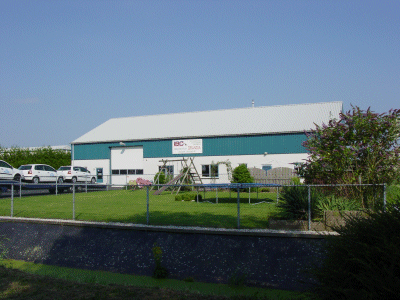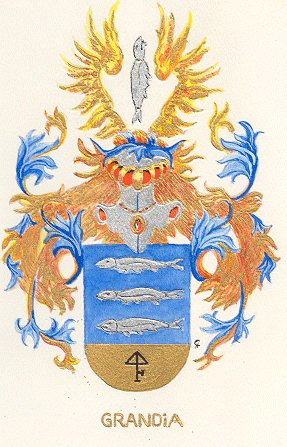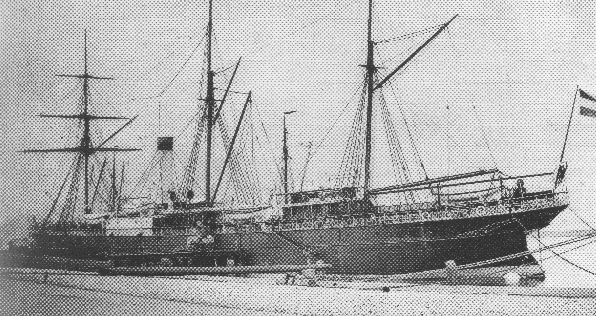Origins
 |
| The Duke of Alva. 18th-century engraving |
The family name Grandia most likely originated in Catalonia (a region in North-eastern Spain). The name first appears in the Netherlands over 400 years ago. The first Grandia arrived in the Low Countries about 1572 as a soldier in the Spanish army commanded by the Duke of Alva (picture left). Alva's army had been sent to the Netherlands to suppress the Protestant-led revolt and reassert the authority of King Philip II of Spain. Very little is known about our ancestor other than that his first name was probably Geraldo. He spent some time in the village of Brakel in the polder (a Dutch word signifying "an area enclosed by dikes") called "Bommelerwaard", bounded by the rivers Maas (to the south) and Waal (to the north). He had a relationship with a local woman, who - sometime between 1572 and 1580 - bore him a son called Sebastiaen. The young man appears to have been aware of his father's mediterranean origin, because he continued to use the family name and occasionally styled himself "Sebastiaen Geraldo" instead of - as would have been customary had his father been a Dutchman - Sebastiaen Geraertsz.
 |
| Sebastiaen Gerrits' name appears |
| in the register of members of the |
| Reformed Church in Brakel, 1640 |
We have, however, some conflicting information on the early history of the Grandia's in Brakel. I recently obtained a copy of a report by a genealogical researcher named dr. A.J. Kleyn, from Zeist (province of Utrecht, the Netherlands). In the 1960's, Dr. Kleyn carried out some research on behalf of one M.J. Grandia from Eindhoven, who was a descendant of the Driel branch of the family. From this report it appears that the researcher had come across the name "Grandia" in late 16th-c. documents from an archive in Cologne (Germany). Cologne is situated on the river Rhine; from this it would appear that Sebastiaen as a young man made a living as a deck-hand, or later perhaps as skipper, on a Rhine barge.
In the same report one Jan Grandia is mentioned, who was a farmer in the "Monnikenland" immediately to the west of Brakel. Sebastiaen is referred to in the report as a "neef" of Jan's. In Dutch, "neef" can mean either "nephew" or "cousin" - but if the former, Jan himself must have been of an earlier generation than Sebastiaen, and if the latter, Jan's father must have been a brother of Sebastiaen's father. In either case, the family must have been living in the Low Countries since well before 1580, since Sebastiaen is known to have been born about 1580 (he is last mentioned in a document dated Sept. 24th, 1655, in which he is stated to be 75 years old).
According to dr. Kleyn, this Jan Grandia was the father of Claes Grandia, and, therefore, the grandfather of Jillis Claessen, who we'll meet in the next paragraph ("Migration").
If this is indeed the case, it becomes much less likely that a Spanish soldier is the common ancestor of all the Grandia's in the Netherlands (since there was no significant Spanish military presence in the country before 1572), although the family name is undeniably a Spanish one. Regrettably, dr. Kleyn has not seen fit to list his sources in the aforementioned report, making it very difficult to independently check his facts.
From Brakel the family spread to other parts of the Netherlands (and abroad) and is now found in the United States as well as in Spain.Since nowadays it is of course far easier to travel, and move house, over long distances, the family can be found all over the Netherlands - although the density of Grandia's in the original "home areas" (Brakel, Beesd and Hoekse Waard) is still noticeably higher than elsewhere.
A good example is Zuilichem, a few miles east of Brakel:
 
|
| Your address of choice for installing your car radio, alarm or other accessory ... |
If you want to browse the family tree, click here
Migration | Go to top of page |
 |
| Fragment of the "List of armed men", Brakel, 1672 |
Like most families in those days, the Grandia family initially stayed close to their new-found home village. Apart from the occasional marriage to someone from a neighbouring village, the family remained living in and around Brakel until the beginning of the 18th century. The illustration to the right is a fragment of the "List of armed men" from the Manor of Brakel in the "Year of Disaster" (1672), when the Dutch Republic found itself at war with England, France, the bishopric of MŁnster and the archbishopric of Cologne. All over the country, men of military age were being called to arms. Brakel was no exception: at the bottom of the picture we find Jillis (or Gillis) Grandia, born November 22nd, 1654. He is listed as "Gillis Claessen ............. roer", i.e. he was the proud possessor of a firearm (which, at that time, would typically be a smooth-bore matchlock musket). He was, in any case, better equipped than his comrade-in-arms Jan Jansen van Willigen (top), who had to make do with a "helbaert" (a halberd) ...
 |
 |
| Fragment of a deed, dated 1725 | |
 |
|
 |
 |
| The final settlement (fragment) Claas inherits "N:U" (N omine U xoris (Latin) = in his wife's name) |
|
 |
|
Claas later turns up in Amsterdam on April 26th, 1741, together with one Neeltje Grandia, as witness at the christening of Anna Grandia, daughter of Jan Grandia and Anna Maria Gerrads. Two years later, on February 13th, 1742/43, he is again present at the christening of the twins Jan and Magdalena Grandia, son and daughter of Jan Grandia and Magdalena Lokmans. On this occasion the other witnesses are Aletta and Alida Grandia - possibly his daughters by Aletta van Welij.
Not every Grandia who left Brakel did so voluntarily.Jan Grandia (Nov. 30th, 1694 - after 1772) had a compelling reason for doing so: from 1750 to 1757 he was "geconfineert" (locked up) in the "Dul- en Verbeterhuis" (Madhouse and Correctional Institution) in Rotterdam.
Jan had been "put away" because of his excessive drinking and violent quarrels with his wife, Maria Buijs.
Some years ago mr. F.F.J.M. Geraedts (at present Municipal Archivist of Leidschendam (a suburb of the Hague)) wrote an article on Jan and Maria's troubled marriage. Mr. Geraedts has been so kind as to allow republication of the article on this website.
The "confinement" of Jan Grandia
Driel
At some time between 1650 and 1750 at least one Grandia moved to the village of Driel, about thirteen miles to the south-east of Brakel, on the north bank of the river Maas. The earliest known "emigrant" to another area of the Netherlands was Lambert Jillisz. Grandia, who was born in Brakel in 1691 and moved to 's-Gravendeel (a village roughly 10 miles south of Rotterdam) in the early eighteenth century.
There still is a considerable amount of uncertainty about this move, and even about the people involved! See The singular case of the two Lammerts for details.
The Grandia's living in the Hoekse Waard - like their ancestors in Brakel and environs - were mostly farmers and farm labourers. Especially this latter category traveled around a lot, depending on where they could find work. This is obvious from civil records, in which you find them living in a number of different villages in the area at various dates. The end of the 19th century was a difficult time for farmers, and consequently quite a few of them eventually migrated to Rotterdam, which was just starting its growth into becoming the world's busiest seaport and needed all the labour it could get.
 |
| Wedding announcement of Willem Merkens and Egelina Grandia, 1914 |
| (Click on picture for full-scale image) |
 | From Beesd and MariŽnwaard some Grandia's moved on again. Ruth Grandia (born in MariŽnwaard in 1869) eventually settled in Apeldoorn. He died there in 1954 and was buried in a family plot in "Heidehof"-cemetery in Ugchelen, just to the south-west of Apeldoorn. His widow Willempje Grandia-Langendoen and his son Willem (who was killed in an accident less than nine months after the death of his father) are buried there as well. I visited the cemetery in May 2002 and, as you can see, the grave has been well looked after (see pictures). The top picture shows the slab itself, the bottom picture presents a view of the path alongside which the grave is situated. |
 | |
Some members of this branch of the family eventually found their way to Rotterdam - apparently unaware of the fact that a number of their relatives had settled in "Zuid" (the "new" part of Rotterdam on the southern bank of the river Maas)!
Another migrant, Dirk Grandia (1794 - 1866) removed from the Bommelerwaard to Middelburg (the capital of the province of Zeeland) on the island of Walcheren. He lived there for a couple of years and married Marie Margrieta Mass on May 25th, 1821. His eldest son Arie Willem moved to Haarlem (15 miles west of Amsterdam), where he died in 1880. Reproduced below is the birth-certificate of Dirk's son Adriaan Philippus, born in Middelburg on July 25th, 1822. This is a rather special item - records from Middelburg are notoriously incomplete due to a number of fires, and also to bomb damage during World War II.
 |
| Birth-certificate of Adriaan Philippus Grandia, born in Middelburg on July 25th, 1822 (scan provided by Joop and Ank van der Glas-Grandia) |
The coat of arms | Go to top of page |

The coat of arms, which also appears as a background on this website, dates from the mid-eighteenth century. Is was first borne by Jielis Grandia, born in Brakel on Nov. 9th, 1738. According to an article in the March, 1974 issue of the monthly of the Dutch Genealogical Society, Gens Nostra, the coat of arms was registered with the Geldersche Leenkamer, an administrative body which in medieval times was charged with the registration of feudal land-holdings and related matters ("leenman" being the Dutch word for "vassal"). By the 18th century many of these feudal rights were still in existence (many were only abolished after the French revolutionary armies invaded the Low Countries and established the Batavian Republic in 1795). The Leenkamer also kept heraldic records in order to prevent mis-use of coats of arms belonging to the old nobility.
The shield shows three fishes (possibly salmon). The Waal river was rich in salmon in those days, and salmon fishery was an important part of the local economy. The coat of arms of the village of Brakel shows two salmon back-to-back. The symbol on the lower half of the shield is a family mark, which was used to indicate ownership of farm carts, cattle and other movables in a largely illiterate community.
America | Go to top of page |
The first Grandia to move to the United States was Jacob Jillisz. Grandia (1822 - 1868). He was born in 's-Gravendeel, a village to the south of Rotterdam. He left the Netherlands in April 1847 as part of a group of religious dissidents known as the "Afgescheidenen" or Seceders. They had a doctrinal conflict with the State-approved "Hervormde kerk", which led to them being harrassed and their church services being disrupted. When it became clear that the Dutch government was not willing to let them worship undisturbedly, some of the more adventurous, led by their dominees Hendrik Scholte, Albertus van Raalte and Seine Bolks left for the American Mid-West. The Rev. Scholte and his followers founded the community of Pella in south-east Iowa.
 Jacob raised a family in his new homeland and died in Pella in 1868.
His eldest son Jillis (1850 - 1923) left Pella for Orange City. In 1883, he seems to have received a letter from my great-grandfather Johannes Grandia (1835 - 1886). This letter is presumed lost, but Jillis' reply has survived. A fragment, showing Jillis' signature ("respectfully, your Cousin Jillis Grandia"), is shown here. Click on the fragment to see the original letter and read a translation.
Jacob raised a family in his new homeland and died in Pella in 1868.
His eldest son Jillis (1850 - 1923) left Pella for Orange City. In 1883, he seems to have received a letter from my great-grandfather Johannes Grandia (1835 - 1886). This letter is presumed lost, but Jillis' reply has survived. A fragment, showing Jillis' signature ("respectfully, your Cousin Jillis Grandia"), is shown here. Click on the fragment to see the original letter and read a translation.
The Dutch East Indies | Go to top of page |
During the course of the 19th century we find a few Grandia's recorded in the Dutch East Indies (modern Indonesia). The records for the Dutch East Indies are, unfortunately, far from complete. The Japanese occupation, the Indonesian fight for independence and tropical insects have wrought havoc with the records. Much of what was left remains to this day in the Indonesian National Archive, and only part of this material has been microfilmed and made available to researchers in the Netherlands.
Nevertheless, some members of the family can be traced to, or in, the colonies. One of them was Gerrit Grandia, born in Driel on November 25th, 1843. He volunteered for military service in the East. With the other members of his replacement company he transferred from the Colonial Service Depot in Harderwijk for Nieuwediep (the present-day naval base at Den Helder), where he embarked on the brand-new "Willem III", the first steamer specifically built for the Far East route.
 |
 |
| "Willem III" tied up alongside the quay in Nieuwediep Naval Base (present-day Den Helder) | |
 |
|
Gerrit spent a number of years in the Indies as a medical orderly and returned to Rotterdam on October 9th, 1883. There are records of a marriage between one Gerrit Grandia and Jacoba Louisa van Rosmalen in Semarang, Java, on May 9th, 1879 (and a subsequent divorce in Madioen, Java, on March 30th, 1881). The couple appears to have had two children: Antoinette Louis(a?) Grandia, who died in Semarang on May 30th, 1879, and Josephine Grandia, born in Semarang on November 4th, 1880. Since the source for the wedding is an extract from the civil records rather than the actual wedding certificate, there is no hard evidence that this is the same Gerrit referred to above.
Another Gerrit was less lucky. Gerrit Arie Grandia, born August 20th, 1875 in Beesd (in the province of Gelderland), was drafted into the Dutch Army in 1895, transferred to the Dutch East Indies Forces and sent out to the East where a war was in progress against insurgents in Aceh (north Sumatra). In July 1897 he came back home, but signed up for another tour of duty in the East. He left for Sumatra on April 28th, 1898, and died at Sigli on July 18th, 1902, after being wounded in action.
A few other Grandia's appear in East Indies sources, such as:
- Louis Alexander Eduard Grandia, born in Batavia (present-day Jakarta) on June 23rd, 1898 and died there on June 26th, 1898
- The headstone of Sophia Adriana Philippina Meischke, born Grandia. She was born in Semarang on October 21th, 1870 and died in Buitenzorg (Bogor) on November 21st, 1904. She was buried in Tanah Abang (Weltevreden) cemetery in Batavia, together with her two children. (Buitenzorg was the official residence of the Governor-General of the Dutch East Indies, and many of its inhabitants were high-ranking officials).